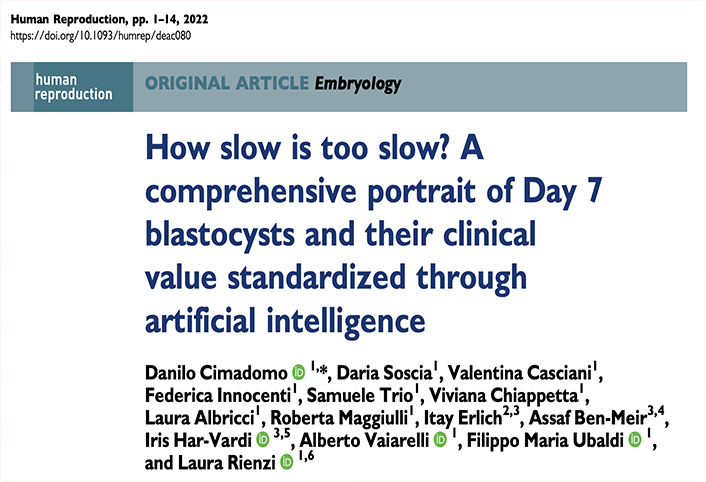
Danilo Cimadomo, Daria Soscia, Valentina Casciani, Federica Innocenti, Samuele Trio, Viviana Chiappetta, Laura Albricci, Roberta Maggiulli, Itay Erlich, Assaf Ben-Meir, Iris Har-Vardi, Alberto Vaiarelli, Filippo Maria Ubaldi and Laura Rienzi
Human Reproduction, deac080, https://doi.org/10.1093/humrep/deac080 Published: 23 April 2022
Abstract
STUDY QUESTION: What is the clinical value of Day 7 blastocysts
SUMMARY ANSWER: Ending embryo culture at 144 hours post-insemination (h.p.i.; i.e. 6 days) would involve 7.3% and 4.4% relative reductions in the number of patients obtaining euploid blastocysts and live birth(s) (LBs), respectively.
WHAT IS KNOWN ALREADY: Many studies showed that Day 7 blastocysts are clinically valuable, although less euploid and less competent than faster-growing embryos. Nevertheless, a large variability exists in: (i) the definition of ‘Day 7’; (ii) the criteria to culture embryos to Day 7; (iii) the clinical setting; (iv) the local regulation; and/or (v) the culture strategies and incubators. Here, we aimed to iron out these differences and portray Day 7 blastocysts with the lowest possible risk of bias. To this end, we have also adopted an artificial intelligence (AI)-powered software to automatize developmental timings annotations and standardize embryo morphological assessment.
STUDY DESIGN, SIZE AND DURATION: Observational study including 1966 blastocysts obtained from 681 patients cultured in a time-lapse incubator between January 2013 and December 2020 at a private Italian IVF center.
PARTICIPANTS/MATERIALS, SETTING, METHODS: According to Italian Law 40/2004, embryos were not selected based on their morphology and culture to 168 h.p.i. is standard care at our center. ICSI, continuous culture with Day 5 media refresh, trophecto- derm biopsy without assisted hatching and comprehensive chromosome testing (CCT) to diagnose full-chromosome non-mosaic aneuploi- dies, were all performed. Blastocysts were clustered in six groups based on the time of biopsy in h.p.i. at 12hr intervals starting from <120 h.p.i. (set as control) up to >168 h.p.i. Blastocyst quality was assessed using Gardner’s scheme and confirmed with AI-powered soft- ware. AI was also used to automatically annotate the time of expanding blastocyst (tEB) and the hours elapsing between this moment and the achievement of full expansion when blastocysts were biopsied and vitrified. Also, blastocyst area at tEB and at the time of biopsy was automatically assessed, as well as the hour of the working day when the procedure was performed. The main outcomes were the euploidy rate and the LB rate (LBR) per vitrified-warmed euploid single blastocyst transfer. The results were adjusted for confounders through multivariate logistic regressions. To increase their generalizability, the main outcomes were reported also based on a 144-h.p.i. cutoff (i.e. 6 exact days from ICSI). Based on this cutoff, all the main patient outcomes (i.e. number of patients obtaining blastocysts, euploid blastocysts, LBs, with supernumerary blastocysts without a LB and with surplus blastocysts after an LB) were also reported versus the stan- dard care (>168 h.p.i.). All hypothetical relative reductions were calculated.
MAIN RESULTS AND THE ROLE OF CHANCE: A total of 14.6% of the blastocysts reached full expansion beyond 144 h.p.i. (5.9% in the range 144–156 h.p.i., 7.9% in the range 156–168 h.p.i. and 0.8% beyond 168 h.p.i.). Slower blastocysts were of a worse quality based on the evaluation of both embryologists and AI. Both later tEB and longer time between tEB and full blastocyst expansion concurred to Day 7 development, quite independently of blastocyst quality. Slower growing blastocysts were slightly larger than faster-growing ones at the time of biopsy, but no difference was reported in the risk of hatching, mainly because two dedicated slots have been set along the working day for these procedures. The lower euploidy rate among Day 7 blastocysts is due to their worse morphology and more advanced oocyte age, rather than to a slower development per se. Conversely, the lower LBR was significant even after adjusting for con- founders, with a first relevant decrease for blastocysts biopsied in the range 132–144h.p.i. (N1⁄476/208, 36.5% versus N1⁄4114/215, 53.0% in the control, multivariate odds ratio 0.61, 95% CI 0.40–0.92, adjusted-P 1⁄4 0.02), and a second step for blastocysts biopsied in the range 156–168 h.p.i. (N 1⁄4 3/21, 14.3%, multivariate odds ratio: 0.24, 95% CI 0.07–0.88, adjusted-P 1⁄4 0.03). Nevertheless, when the cutoff was set at 144h.p.i., no significant difference was reported. In this patient population, ending embryo culture at 144h.p.i. would have caused 10.6%, 7.3%, 4.4%, 13.7% and 5.2% relative reductions in the number of patients obtaining blastocysts, euploid blastocysts, LBs, supernumerary blastocysts without an LB and surplus blastocysts after an LB, respectively.
LIMITATIONS, REASONS FOR CAUTION: Gestational and perinatal outcomes were not assessed, and a cost-effectiveness analysis is missing. Moreover, we encourage other groups to investigate this topic with different culture and biopsy protocols, as well as in different clinical settings and regulatory contexts.
WIDER IMPLICATIONS OF THE FINDINGS: In view of the increasing personalization and patient-centeredness of IVF, whenever allowed from the local regulations, the choice to culture embryos to Day 7 should be grounded on the careful evaluation of couples’ reproductive history. Patients should be aware that Day 7 blastocysts are less competent than faster-growing ones; still, poor prognosis couples, couples less compliant toward other attempts in case of a failure and couples wishing for more than one child, may benefit from them. AI tools can help improving the generalizability of the evidence worldwide.
STUDY FUNDING/COMPETING INTEREST(S): This study did not receive any funding. I.E., A.B.M. and I.H.-V. are employees of Fairtility Ltd.
TRIAL REGISTRATION NUMBER: N/A.